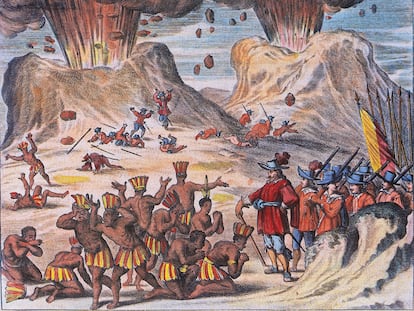‘Mexican Spanish is permeated by indigenous languages’
Academic Concepción Company talks to EL PAÍS about the linguistic richness in Mexico and this changed following the fall of the Aztec Empire and independence

Linguist Concepción Company was born in Madrid and became a naturalized Mexican citizen in 1978. She is a member of the Mexican Academy of Language, and as an academic with a foot on both sides of the Atlantic, she has a particular vision of the language that arrived from Europe more than 500 years ago with the conquest of Mexico. It is a version of Spanish shaped by the sea and sailors, she explains, and also by dozens of indigenous languages from all over Latin America. Rather than an imposed language, she considers Mexican Spanish to be proudly itself, and in continuous conflict with indigenous languages.
To mark the 500th anniversary of the fall of the Aztec Empire on August 13, Company spoke with EL PAÍS about the Spanish conquest of Mexico right up to Mexican President Andrés Manuel López Obrador’s demand for an apology from Spain for the events of the past. “It wouldn’t cost Spain anything,” Company believes. “But I believe that both sides are there negotiating, and weighing their votes, and it’s not going to happen.”
Question. What was the linguistic landscape like in Tenochtitlan in 1521?
Answer. Before the fall of Tenochtitlan, a whole multitude of languages were spoken. In present-day Mexico we have 68 linguistic groups, or families, which we call “trunks.” Some are single languages, such as Purepecha, and some are complex linguistic groups, like Zapotec, which incorporates quite a few languages. All of these, and surely more, were spoken at the time of [Spanish conquistador] Hernán Cortés’ arrival. Not all of these languages had the same social function. Nahuatl was the lingua franca, the language of the [Aztec] Empire, but the Nahuatl of Sierra [Norte] de Puebla is distinctive from the Nahuatl of Milpa Alta. There are even variants of Nahuatl that are not mutually intelligible.
Many Mexicans still feel that Spanish is an imposed language, and do not feel that this is their language
Q. And what language arrived?
A. The language of a handful of Spaniards arrived, which was not a homogeneous language, because there were people from Extremadura and Andalusia, and so on. We must remember that the Spaniards who arrived in what is known today as the Republic of Mexico had spent a long time in Cuba or the Dominican Republic. They were linguistically acclimatized to a ‘flat’ kind of Spanish, because they were influenced by many dialects, in a very complex human melting pot. That flattening has Andalusian influences, because there were many Andalusians, and because the zone permitted for embarkation to America was in Seville. In order to embark, permission had to be requested from the Casa de la Contratación [Crown Agency for the Spanish Empire], and it could take months or even years. So Seville in the 16th century was a polyglot capital, because ‘the race to the Indies’ was fought by Andalusians, Castilians, Basques, Catalans, French and Germans. And there were also many Jews and many Muslims, as let us not forget that a few decades earlier the Catholic Monarchs had taken the Kingdom of Granada. We must get rid of the idea that a homogeneous Spanish arrived. What came [to Mexico] was Spanish with many dialects influenced by Andalusia and the Caribbean.
Q. In a recent lecture, you said that the sea molded Mexico’s lexicon. What were you referring to?
A. Totally, we are heirs of the sea. But not only Mexico, much of America was also molded by the sea. Imagine that very intimate coexistence [on the ships that traveled to America], in unimaginable conditions, with horrific diarrhea. These very diverse dialects were coexisting in order to survive. These voyages lasted four to five months, and people adopted and added to the maritime lexicon. For example, the word zafarrancho [havoc, mess] is a maritime word: what the passengers did was to establish their rancho [ranch], the place to store their trunks. And if they were going to be shipwrecked, or there was an enemy ship, they had to break up the rancho to level the ship. The word cobija [blanket], which comes from cubículo [cubicle], is a sailor’s word.
Q. How was Spanish shaped when it met the indigenous languages of Mexico?
A. When you arrive in a new place, you have to dominate it, get to know it, and part of that mechanism of appropriation is to name things. So what did the Spaniards do? The first thing they did was to appropriate and name reality. There were several different strategies. One was to name things by what they heard: they began to incorporate indigenous words into Spanish. The proof that they did not always hear the same thing is that sometimes there are six, seven or eight spellings for the same word. This is a sign that in the indigenous languages – Nahuatl, Mayan, Mixtec, Zapotec – there was already variation. There are about nine spellings of the word ‘[Aztec Emperor] Moctezuma,’ for example, and that also happens with the word pulque [a fermented drink].
A fundamental principle of the survival of the Spaniards was naming things because they had to describe them for the king in the chronicles they wrote home. When writing about what they had done, the very rich world of the Americas appears, full of words from indigenous languages: Chalchihuite, pulque, tomato, chocolate, hundreds of words.
A conquering language can be recognized as such because it is restricted to specific uses: Spanish was used for commerce, for administration and for religion
Another way of naming is to use words from one’s own language. So pimiento [pepper], for example, is a Latin word, from pigmentum, but chili peppers are from the Americas. It was renamed with a Latin word because they did not know what to call it. There is a whole dispute between pigmentum, chili, and aji. Ají is Caribbean, chili is Nahuatl, and pimiento is Latin. All describe and refer to the many species of peppers that exist in the Americas. What is also certain is that at the beginning, at least in the 16th century, the indigenous languages entered Spanish directly, with some very early adaptation, such as the final ‘e’ that Spanish adds to ‘tomato’ [tomate] or ‘chocolate.’ Because they could not pronounce the -tl at the end of tomatl, they called it tomate. That ‘e’ is a way of adapting it to the Spanish language.
Q. You have questioned whether Spanish in Mexico should be understood as an imposition.
A. Yes, from the very beginning. A conquering language can be recognized as such because it is restricted to specific uses: Spanish was used for commerce, for administration and for religion. But some Spaniards learned Nahuatl. In the 16th century, there was a coexistence of three languages: Spanish was the language of conquest; Latin was the language of science (the printing press printed many things in Latin, as it was the language of the academy); and there was the Nahuatl language, which was the language of daily life, spoken by many people. But we must make it very clear that there were also Nahuatl-speaking notary offices, there were Nahuatl administrations and it was independence that put an end to these.
Q. You have said: “Mexican independence [in 1810] is the worst thing that could have happened to indigenous languages.” Why?
A. Yes, that was the final straw. The 19th century was the child of the Enlightenment, without a doubt, and what interested the Enlightenment was the development and progress of mankind. And how was this progress going to happen? It was easier to do it in one language than with many. Nahuatl notaries completely disappeared in the 19th century. Independence meant an inhibition in the use of indigenous languages, because the official discourse inhibited the use of indigenous languages. Nobody is forbidden to speak Nahuatl, but Nahuatl would no longer be useful when going to a notary’s office or to make a will, because there are no longer any Nahuatl notaries. This is a process that has been going on for 300 years, and it is very complex. One other blow to indigenous language was the change of dynasty from the Habsburgs to the Bourbons.
Q. Why?
A. Because the Habsburgs always had a policy of separating the Indian villages from the Spanish villages. Divide and conquer. Separate them and then each one is in their corner and I can control them better. But in that separation, there was a great respect for their customs, legislation and indigenous ways of life. The Habsburg dynasty respected the separation of Indian villages and they used intermediaries. Documents show that they were Spanish-speaking Indians, in the sense that they spoke both languages. They spoke Zapotec and Spanish, for example.
When the Bourbons ascended the Spanish throne, they totally centralized the administration. They eliminated the separation of indigenous towns and Spanish towns, and of course imposed Spanish. Remember that they had been living together for 200 years, and that the Indians had also adopted Spanish because it was more fluid and faster for them to communicate in Spanish than to communicate in Nahuatl and to look for an interpreter. That was not because of ‘how nice it sounds.’ It was purely for survival.
What came to Mexico was Spanish with many dialects influenced by Andalusia and the Caribbean
Q. To survive, you have to speak the language of power.
A. Of course, here and anywhere in the world. But what I think is important to say is that little by little the Spanish of Mexico was permeated by indigenous languages. First, it was permeated by the sea, and we still have the sea, although we do not see it in our daily life. And in today’s Mexican Spanish and in a large part of Central America there is a profoundly mestizo Spanish, where we have phrases made and constructed basically with a mixture of Spanish and indigenous languages. There is also a very clear process in Mexican Spanish of substitution with the indigenous lexicon. For example, in Mexico, apapachar is preferred to mimar [indulge, spoil]. Pita or mecate is preferred to cuerda [rope]. Today there is a process of substitution of the Latin lexicon in favor of the indigenous lexicon, and everyday Mexicans do not notice that this has taken place, and that it is a profound fusion.
Q. This has been a major focus of your work. That the Spanish that feels so imposed in Mexico that is actually more Mexican than is recognized.
A. Yes, there is a very deep fusion. However, from the official discourse, and not only now but always, there is an idea that Spanish is an imposed language. You ask a Mexican and he feels conquered, and he feels that it is an imposed language. And you ask him, “What other language do you speak? He says none, that he does not speak any indigenous language. But there has been a process that seemed to happen in the post-post-post-colonization stage. Because there was a very deep process of mixing with Spanish. I will give you another example of substitution. Here we say buena pal petate, mala pal metate [roughly: bad in the kitchen but good in bed]. The adjectives ‘good’ [buena] and ‘bad’ [mala] are from Spanish, and the other words are from indigenous languages, in this case, Nahuatl. Or chapulinear, to speak of a politician. And the word chapulines is preferred to the word saltamontes [all relate to the word for grasshopper], which has been eliminated in favor of indigenous versions. Nevertheless, many Mexicans still feel that Spanish is an imposed language, and do not feel that this is their language. And the official discourse has contributed to this since independence, because they have rescued the indigenous world in a rather impractical way, I would say. They have not rescued anything, nor have they given a better quality of life to the indigenous people.
Q. What do you mean when you say that indigenous languages today are in conflict?
A. It is a sociolinguistic concept to say that two languages are in consensus when with either language you can function in any facet of life, and you can climb the social ladder with either language. Like Hindi or English in India, or Catalan and Spanish in Spain. And they are in conflict when you only have quality of life with one of them. And unfortunately in Mexico, there has never been a relationship of consensus. Spanish and the indigenous languages have always been in conflict. The indigenous people learn Spanish because it will allow them, for example, to increase their salary.
Q. Is Mexico far off from a consensus?
A. Absolutely. We would have to generate quality employment in the areas where the majority of indigenous languages are spoken. This is a socio-linguistic experiment that has already happened in many countries around the world, where you force the factory manager to learn the indigenous language. You generate quality of life. But for now, everything is done in Spanish, even though it is a language that continues to be seen as an imposed language. We have to have some coherence: if we see it as imposed, let’s do something so that the indigenous people can, for example, receive their paycheck in their own language.
Q. What do you think of López Obrador demanding Spain apologize for the conquest of Mexico?
A. It seems to me that it will not cost him anything, although history cannot be taken out of context, and that is what I think is being done. Well, the Spanish conquest was indeed imposed, and it had moments of light and darkness. And I think it would cost the Spanish monarchy nothing to say: ‘yes, we made mistakes.’ But that was another dynasty. Well, nothing would happen if the mistakes of the past were recognized. The world would continue to function in the same way, and Spanish-Mexican cooperation would continue to function in the same way. You could do it and there would be no problem. Although it seems out of context to me... and they ask for it in Spanish.
Tu suscripción se está usando en otro dispositivo
¿Quieres añadir otro usuario a tu suscripción?
Si continúas leyendo en este dispositivo, no se podrá leer en el otro.
FlechaTu suscripción se está usando en otro dispositivo y solo puedes acceder a EL PAÍS desde un dispositivo a la vez.
Si quieres compartir tu cuenta, cambia tu suscripción a la modalidad Premium, así podrás añadir otro usuario. Cada uno accederá con su propia cuenta de email, lo que os permitirá personalizar vuestra experiencia en EL PAÍS.
¿Tienes una suscripción de empresa? Accede aquí para contratar más cuentas.
En el caso de no saber quién está usando tu cuenta, te recomendamos cambiar tu contraseña aquí.
Si decides continuar compartiendo tu cuenta, este mensaje se mostrará en tu dispositivo y en el de la otra persona que está usando tu cuenta de forma indefinida, afectando a tu experiencia de lectura. Puedes consultar aquí los términos y condiciones de la suscripción digital.











































